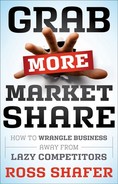Chapter 1
First, You Must Attack Market Share
Are You Merely Striving for Average?
Do you want to settle for 1 to 2 percent growth in the recovery?
Even the best-informed economists believe the current market may grow at a rate of between 1 and 2 percent. That's hardly a snapback recovery, is it? But will your stakeholders and board members settle for 1 percent? Of course they won't.
What if your particular segment happens to be in a declining market? That is to say, demand for what you sell is declining. Should you give up; simply roll over and blame the economy or the competition? No, you shouldn't; that would be ridiculous. If you want to grow in a slowly recovering economy, a stagnant economy, or even a declining market, your best—and truly, only—plan is to “steal” market share from your competitors.
Maybe you don't like the word steal and prefer to use win. Whatever term you use, know that your survival depends on wrestling business away from other companies that do what you do and provide what you provide.
This is a lesson we learned from none other than fast-food linchpin McDonald's. The company noticed there was probably a wild growth opportunity in the specialty coffee and smoothie business and that people were increasingly enamored of places like Starbucks and Juice It Up, which were growing at impressive rates. Though McDonald's had actually tested its McCafé concept many years earlier, the company didn't officially launch the initiative until early 2009. By doing so, it charged Starbucks full bore, and Starbucks had already begun to cut prices in some markets due to the economy. McDonald's, which saw and took advantage of the vulnerability in Starbucks' market share, acted on a fundamental truth: Capitalizing on a competitor's weakness is always a solid recovery strategy. McDonald's plan was to roll out the McCafé concept to 11,000 of the company's 14,000 locations, with a goal of pulling in a projected $1 billion in revenue. It worked. In the second quarter of 2010, McDonald's raked in $420 million, thereby making its billion-dollar target a reality.
It's important for you to absorb the fact that McDonald's did not create a fresh billion dollars in coffee consumption. Rather, it stole a staggering amount of business from Starbucks and other coffee specialty stores. Starbucks felt the pressure and, in 2009, closed more than 270 locations.
Subway, with its 34,000 sandwich locations, was also paying attention to these latest developments and decided accordingly to venture into the breakfast business. Since Subway already had most of the necessary ingredients to make sandwiches, it just added English muffins and eggs. Subway, too, was hoping to grab an additional revenue stream of $1 billion. I was at a launch meeting for this concept, and the hushed murmur making its way through the managerial crowd was, “If we start selling breakfast sandwiches, does that mean we have to get to the store an hour earlier?” I said to myself, “Yeah—but isn't an hour earlier worth an extra billion dollars!?”
A regional director of that chain told me during a recent phone call, “Revenue hasn't [climbed] quite as high as we'd hoped, but [this move] proved we could be nimble and react to our market's needs. Adding breakfast was a very smart move for us . . . although I do have to go to bed a little earlier these days.”
Moving from the food service industry to online retail, we have to admire Zappos.com as a pure model of a company that came to the industry late, yet ramped up its quest to gobble market share. You are probably aware of the Zappos story by now; if you're not, it's fair to say that Zappos.com is the Amazon.com of the retail shoe business. The company started in 1999 with a fairly simply business model: to sell shoes over the Internet. Given that most people (at that time) liked to try on a lot of different shoes in the relative safety of a retail store (“I don't want these . . . but these”), ordering shoes over the web—sight unseen and foot unfelt—wasn't an easy behavior to change. Nonetheless, by being overly customer focused, Zappos.com grew from zero to a billion-dollar-plus shoe company in just 10 years.
Again, Zappos.com didn't convince consumers to buy an additional billion dollars' worth of shoes. The company recognized that some of its largest competitors assumed that they had the discount shoe market cornered. Hubris always makes a competitor vulnerable. Zappos.com identified its softest targets and stole the business from formerly worthy competitors. To wit, Payless ShoeSource had closed 218 stores by 2009.
Guess what else happened? Zappos.com was purchased by the company that inspired its business model. In July 2009, Amazon.com bought Zappos for $928 million.
The same take-it-from-your-competition strategy was used by home electronics industry behemoth Best Buy. Recognizing that its largest competitor, Circuit City, had a customer service Achilles' heel, Best Buy painted its target and devised a strategy. Through a studied regimen of offering extreme customer service—and by installing a new employee work model (called ROWE, which we'll discuss in detail later in this book)—Best Buy applied so much market pressure that Circuit City was forced to shut down 567 stores. Others fell as well: Sam Goody buttoned up 340 locations, and Good Guys lost 71. Even Crazy Eddie succumbed, with more than 40 closures. Best Buy performed a serious, tactical theft of market share that resulted in significant and lasting company growth.
